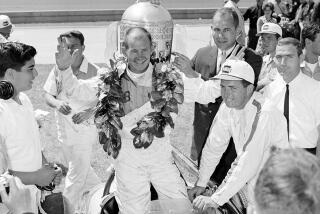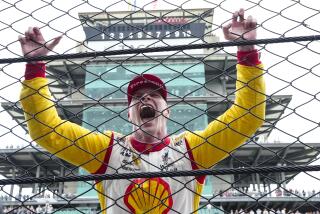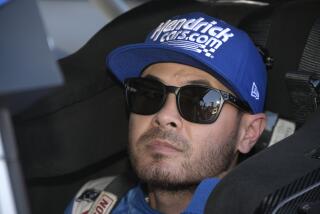No Beginner, Piquet Possible Indy Rookie
INDIANAPOLIS — The U.S. Auto Club’s Rookie Orientation Program is billed as optional, but there’s really no choice.
A first-year driver who passes up this weekend’s testing might just as well watch the Indianapolis 500 at home on television next month. That’s as close to the starting lineup as he’ll likely get.
“It is optional, of course, but it is primarily to give new people an opportunity to come here and get familiar with the facility, with the people here who will be conducting the event, in an atmosphere that’s much more relaxed than in May,” says USAC spokesman Dick Jordan.
The possible 1992 crop includes three-time world Formula One champion Nelson Piquet of Brazil; Lyn St. James, a veteran road racer who is trying to become the second woman driver in the Indy 500 and the first since Janet Guthrie a dozen years ago; Ted Prappas and Mark Dismore, who passed their rookie tests last year but were unable to qualify after crashing their cars; and Canadian Paul Tracy, the latest protege of car owner Roger Penske, a teammate of four-time winner and defending champion Rick Mears and, at age 23, the youngest driver entered for the May 24 race.
None of those drivers or, for that matter, the other half-dozen or more expected to challenge Indy for the first time, are beginners. But Indy tradition, as well as the 2 1/2-mile oval track’s demanding straightaways and narrow, low-banked corners, demand they bear the epithet “rookie” until they have driven in this race, the richest and most prestigious in the world.
That’s why every lap, every minute of testing, during the three-day program that ends Sunday puts them closer to a spot in the 33-car lineup four weeks later.
“Track time is of the utmost importance,” Jordan said. “It’s something first-year people look forward to. They’re not being passed every lap by cars going 230 m.p.h. They can get out and work up to speed and progress in a normal fashion.”
It also allows the drivers to complete three of the required four phases of the rookie test without the daily chaos that will begin when the track opens for practice on May 2. The last phase, 10 consecutive laps at 200 m.p.h or above, must be done after that under observation by a panel of USAC officials and veteran drivers.
Other rookie drivers this year could include Eric Bachelart of Belgium, the 1991 Indy Lights champion; Brian Bonner, the IMSA GTP rookie of the year in 1991; Gregor Foitek of Switzerland, a former Formula One driver and protege of A.J. Foyt; Philippe Gache of France, another road racing veteran; Jovy Marcelo of the Philippines, the 1991 Toyota Atlantic champion; Kenji Momota of Japan, who drove in the American IndyCar Series in 1989 and Indy Lights the past two years; and Jim Vasser, who won 11 races in the Canadian Formula 2000 and Formula Atlantic series since 1990.
The Rookie Orientation Program began in 1981, and three of the four first-time winners since then were ROP graduates--the one exception was 1989 winner Emerson Fittipaldi, who passed it up as a rookie in 1984. Danny Sullivan (the 1985 winner), Bobby Rahal (1986) and Arie Luyendyk (1990) all took part in the ROP.
“In terms of doing its job, it’s been unbelievable,” Jordan said. “Everybody has seen the benefits of this thing. We’ve had people come here who had never been on a superspeed oval like this and they’ve done very well.”
Of the 62 rookies who have driven in the race since 1981, all but nine participated in the ROP. Besides Fittipaldi, the only other ROP no-shows among the 38 rookies who have qualified since 1984 were Rich Vogler in 1985 and Phil Krueger in 1986.
All 23 rookie starters from 1987-91, including rookies of the year Fabrizio Barbazza in 1987, Bill Vukovich III in 1988, Bernard Jourdain and Scott Pruett in 1989, Eddie Cheever in 1990 and Jeff Andretti last year, were ROP graduates.
The two rookies who likely will get most of the attention this year are Piquet and St. James.
St. James, 45, who lives in Fort Lauderdale, Fla., began racing sports cars in 1976. She teamed with three men to win the IMSA GTO division of the 24 Hours of Daytona in 1987, and broke her own women’s closed-course record with a lap of 212.577 m.p.h at Talladega. She first tested at Indianapolis in 1990, but this is her first time as an entrant with Paragon Motorsports.
Piquet, 39, who attended school in California, started racing go-karts after returning to Brazil in 1967. He moved to sedan racing, Super Vee and European Formula Three, then made his Formula One debut in 1978 and got the first of his 23 victories in 1980 at Long Beach.
He won Formula One titles in 1981, 1983 and 1987 but has never driven an Indy car race.
“Even for Nelson Piquet, the Speedway is unique,” Jordan said. “It’s unlike any other track in the world. It requires a lot of concentration. For people like Piquet who come here for the first time, it’s like a learning experience, regardless of the experience they have elsewhere.”
Piquet, driving for Team Menard, was tutored during private testing at the Speedway last month by Indy veteran Gary Bettenhausen and “adapted well,” Jordan said.
A week of practice will lead up to pole day on Saturday, May 9, the first of four days of qualifications. Time trials continue on May 10 and May 16-17. Besides Mears, other former winners entered are Fittipaldi, Rahal, Sullivan, Foyt, Luyendyk, Mario Andretti and Gordon Johncock.
More to Read
Go beyond the scoreboard
Get the latest on L.A.'s teams in the daily Sports Report newsletter.
You may occasionally receive promotional content from the Los Angeles Times.










